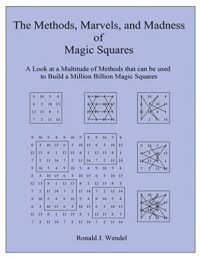Title: The Methods, Marvels, and Madness of Magic Squares: A Look at a Multitude of Methods that Can Be Used to Build a Million Billion Magic Squares
Author: Ronald J. Wendel
Publisher: GoldTouch Press, LLC
ASIN: B0BB52ZG4V
Pages: 404
Genre: Non-Fiction / Education
Reviewed by: David Allen
Hollywood Book Review
What’s so ‘magic’ about magic squares? As it turns out, a great deal!
Non-mathematicians will be surprised to learn that people of all ages are fascinated by these brain teasers. Competitions are held around the globe, Magic square puzzles and solver apps abound on the Internet, and Wikipedia devotes more than 25 pages to their history and spread.
The magic square has been around for at least a thousand years, and its history stretches far and wide. The square’s popularity in China, Japan, India, the Middle East and in post-15th century Europe is well documented. Who knows – perhaps the Reformation, the Enlightenment and the Renaissance arose at least in part due to this numeric wonder? Benjamin Franklin, who supposedly regretted “wasting a year” on these, was certainly a habitué of the pastime.
A magic square is a grid of at least nine numbers, made up of (at least) three columns and three rows. Each column and row, including the diagonal rows, must add up to the same number – the so-called ‘constant’ of the array. Three rows and three columns are only the beginning. Once higher order squares are constructed the 4th order square contains 16 cells, with four rows and columns; the 5th order is a 5 X 5 grid with 25 cells, and so on. The possibilities aren’t quite infinite, but they are astounding. The more elements – the higher the order – the greater the number of squares that can be derived. For example, a 7th order square contains at least 7 X 6 X 5 X 4 X3 X 2 X 1 or 5,040 possible squares. An 8th order square contains more than 40,000. It gets even better. Magic squares can be embedded within larger magic squares. One can ‘fool’ with the numbers – squaring each of them, for example – and thereby create new more recondite squares.
Author Ronald J. Wendel’s enthusiasm for his subject illumines each page of this delightful book. His excitement, his ability to bring recreational and even theoretical mathematics into the lives of general readers is nothing short of terrific. Mathematicians will likewise appreciate the loving attention paid to ‘exceptional’ squares and to geographically and historically important squares. Aficionados of magic squares will surely enjoy the depth of detail on the history and background of their pet game.
Crossword and Sudoku puzzles, step aside: a worthy possibly more venerable challenger has stepped into the ring! Wendel’s clear diagrams, patient exposition and writing will make you a magic square fan too.

